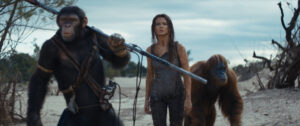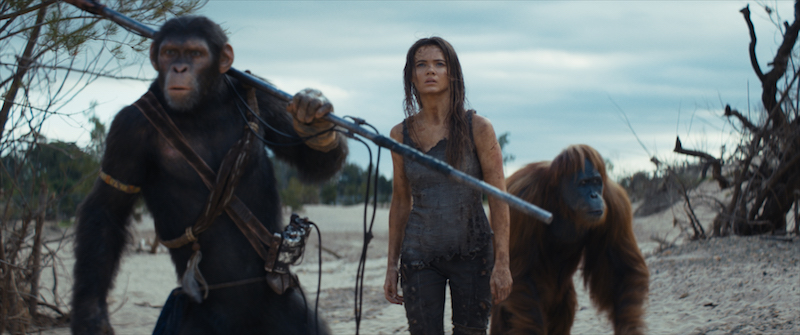I don’t have anything against chimps. In fact, I like ’em.
But I found it hard to care what happened to any of the chimps, other simian critters, or humans in “Kingdom of the Planet of the Apes” (PG-13, 145 minutes, in theaters).
This is the fourth film in the “Apes” reboot that started in 2011 and the 10th feature film in the franchise overall. Maybe that has something to do with why this ho-hum adventure has all of the suspense and excitement of a trip to McDonald’s. (Come to think of it, since I’ve been dieting, an excursion to McDonald’s would be pretty exciting – but you get the idea.)

From left, Noa (Owen Teague), Mae (Freya Allan) and Raka (Peter Macon) appear in a scene from “Kingdom of the Planet of the Apes. Noa looks like a simian version of Mikey Day from “Saturday Night Live” while Raka looks like he stepped off the set of “Harry and the Hendersons.” (20th Century Studios)
The best part of the film, which takes place many generations after the death of the heroic ape leader Caesar, is at the beginning, when three young chimp pals – Noa (Owen Teague), Soona (Lydia Peckham) and Anaya (Travis Jeffery) – go out on a mission to retrieve eagle eggs as a rite of passage. At this point we don’t know who they are, or whether they are important to the story. We don’t know if they’re expendable.
So as they go about the dangerous task of collecting eggs from eagles’ nests, there’s some suspense as to whether they’ll plummet off a mountain perch or get pecked to death by a protective adult eagle.
Meanwhile, the director, Wes Ball (the “Maze Runner” trilogy), engulfs us in the lush jungle scenery, making us feel like we are in the thick of the action while experiencing a strong sense of foreboding. (Cinematographer Gyula Pados’ work is so striking that, if you do see the movie, catch it on the biggest screen possible.)
But after this sequence, as the plot unfolds, “Kingdom” becomes routine, draggy and somewhat confusing. While apes have evolved into the dominant species, humans have become feral scavengers who supposedly can no longer verbally communicate. The apes have divided into clans (though this is not immediately made clear), and Noa finds himself on a mission to save his clan from the forces of the brutal ape tyrant Proximus Caesar (Kevin Durand). Helping Noa along the way are a wise orangutan, Raka (Peter Macon), and Mae (Freya Allan), a human who – surprise – speaks like she could be an English professor.
Like some of the previous movies in the franchise, “Kingdom” questions whether having apes in control of the world is any worse than having humans in charge. Why root for humans – just because we’re human? We’ve certainly had our variations of Proximus.
Throughout ‘Kingdom,” I could have sworn that, beneath the chimp makeup, “Saturday Night Live” regular Mikey Day was playing Noa. It would have been ingenious casting (Day is hilarious). I was disappointed to discover this wasn’t the case, though Teague is fine in the role.
What “Kingdom” really lacks is a character with the impact of Andy Serkis’ ape Caesar from the previous three films. Serkis imbued his Caesar with a gravitas that made his character consistently compelling. “Kingdom” characters, for the most part, are flat. Macon’s kindly old coot Raka seems like he just walked out of a children’s fantasy. while Allan’s Mae has no discernible personality at all. William H. Macy pops up as an eccentric historian who has sold out humanity to Proximus, but his presence doesn’t help, either.
It’s all just the usual monkey business. **½ (out of four)
Heart in the right place
British auteur Ken Loach, 87, has been making movies about social issues and the working class since “Poor Cow” in 1967.
His latest, “The Old Oak” (113 minutes, in theaters), takes place in a depressed town in Northern England where coal mines once thrived but are now long closed.
The film begins with Syrian refugees arriving in town and being attacked by bitter residents who say the immigrants will take away from what few benefits and opportunities the long-suffering locals have.
Middle-aged TJ Ballantyne (Dave Turner), owner of the pub The Old Oak, befriends the new arrivals, who have few possessions after escaping the oppression of Syria’s Assad regime. He becomes close, platonically, to Yara (Ebla Mari), a young woman with a gift for photography, and tries his best to help her and her family.
But some of the regulars at his pub – those who keep him in business – have other ideas. The kind who start sentences with “I mean, I’m no racist, but …,” they groan and hurl epithets at the newcomers, and demand resistance rather than assistance when it comes to helping them.
Tensions, as you might expect, mount, with TJ stuck in the middle.
Written by longtime Loach collaborator Paul Laverty (“Sorry We Missed You,” “The Wind That Shakes the Barley”), “The Old Oak” presents a situation that can be applied elsewhere, including the good ol’ USA, where immigrants are viewed with suspicion or worse, instead of with generosity.
Loach and Laverty not only present the problem, but an answer, though it’s so simple it seems naive. The answer is the last word in the paragraph above: generosity. Or, to elaborate: kindness, understanding and hope, qualities that lead to the building of community. TJ is, to a large degree, the personification of these qualities, but, as the movie also suggests, determination and courage in the face of adversity also are required to follow through with doing the right thing. Good intentions alone aren’t good enough.
Loach has built a career fighting the good fight, and continues to do so, even at this point in his life, with “The Old Oak.” ****
One false move
Once in a while, I’ll see a movie that has the potential for greatness, but I don’t know where it’s leading. “Please don’t blow it, please don’t blow it,” I’ll think. Mike Leigh’s “Happy-Go-Lucky” and my two favorite movies from last year, Wim Wenders’ “Perfect Days” and Celine Song’s “Past Lives,” come to mind. In all three cases, the filmmakers not only don’t blow it, the endings are sublime.

Hitoshi Omika and Ryo Nishikawa play father and daughter in Ryusuke Hamaguchi’s “Evil Does Not Exist.” (Sideshow/Janus Films)
That’s not the case with “Evil Does Not Exist” (106 minutes, in theaters). Co-writer and director Ryusuke Hamaguchi, who delivered a remarkable one-two dramatic punch in 2021 with “Drive My Car” and “Wheel of Fortune and Fantasy,” works his usual magic, in which a seemingly ordinary conversation in a car is as riveting as anything on a battlefield. But then he shifts gears at the end, hammering his point home through forced metaphor. The film suddenly goes from subtle and profound to abrupt and heavy-handed.
Still, “Evil Does Not Exist” delivers more up to that moment than most films deliver from start to finish.
The film is set in the Japanese village of Mizubiki and its pristine, natural surroundings. A company plans to set up a glamping – glamorous camping – site and is rushing to push the project through to take advantage of a subsidy that’s about to run out.
Two representatives of the company, Takahashi (Ryuji Kosaka) and Mayuzumi (Ayaka Shibutani), hold a meeting with the residents. The residents strongly object to the company’s proposed septic tank, which, because of its small size and location, will contaminate the groundwater.
“Your valuable input will be considered,” Takahashi responds, which, as the villagers know, is corporate parlance for “Tough luck.”
One of the village leaders, Takumi (Hitoshi Omika), a handyman and widower who lives with his 8-year-old daughter, Hana (Ryo Nishikawa), is among those concerned, and Takahashi and Mayusumi, on orders from their bosses, return to the village to try to win him over. Meanwhile, the two company reps start to question their own life choices.
In keeping with his usual deliberate pace, Hamaguchi presents extended, unhurried sequences of the village meeting, Takumi chopping wood or filling containers with drinking water, conversations during drives. A less confident, less skilled director would shorten such scenes for fear of boring audiences, but Hamaguchi, like a Leigh or a Wenders, knows how to make the everyday compelling, and he does here.
Until the end. ***
** Click here for Tim Miller’s previous movie columns for Cape Cod Wave **
Please like Cape Cod Wave on Facebook.
Cape Cod Wave Magazine covers the character & culture of Cape Cod. Please see our Longform stories.
Tim Miller is co-president of the Boston Society of Film Critics and a Tomatometer-approved critic. He teaches film and journalism at Cape Cod Community College in West Barnstable. You can contact Tim at [email protected] or follow him onTwitter @TimMillerCritic. Or you can ignore him completely.

































